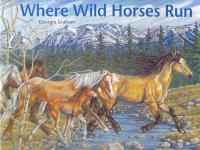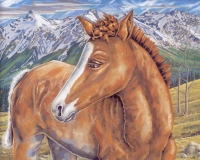| ________________
CM . . . . Volume XVIII Number 15 . . . . December 9, 2011

 |
Where Wild Horses Run.
Georgia Graham.
Markham, ON: Red Deer Press/Fitzhenry & Whiteside, 2011.
32 pp., hardcover, $18.95.
ISBN 978-0-88995-448-9.
Subject Heading:
Horse-Juvenile fiction.
Grades 1-3 / Ages 6-8.
Review by Gregory Bryan.
***½ /4
|
| |
|

excerpt:
Every day the horses wander the meadows, grazing. Then Brown Foal spots movement in the forest. Has Gray Colt returned? Brown Foal prances excitedly. The mares stop grazing. Gold Stallion’s ears stand tall. Suddenly, several unknown mares and a foal appear out of the trees.
Brown Foal whinnies an alert, and Gold Stallion turns around as an enormous roan stallion thunders forward, powerful muscles rippling, his coat shining like the rising sun.
Where Wild Horses Run is an impressive new picture book by Red Deer Press. The book is about the wild horses of the Nemaiah Valley in British Columbia. The descriptive text and lavish illustrations follow one small band of wild horses. Much of the book focuses on the competition for life that is a never-ending aspect of wilderness settings. While searching for food, the horses face threats from a grizzly bear and, later, a cougar. Even among the horses there is life and death conflict.
Where Wild Horses Run was written and illustrated by Georgia Graham who visited the Nemaiah Valley to observe wild horses. Her visit was obviously an inspiring one for she has created an impressive, occasionally poignant book.
Graham’s text is strong. She does a good job of showing, rather than telling. She shows the nervous anxiety of the horses through describing them as doing such things as prancing, snorting, whinnying, and stomping as they travel through grizzly bear country where there are “immense gashes” high on the trunks of trees and the bears’ scent “lingers on the tree bark.”
Graham is careful to avoid anthropomorphism. One of the ways that she does this is by merely identifying the horses, rather than giving them names beyond their appearance or role within their herd. Brown Foal is the central “character,” while Gold Stallion, Roan Stallion, Gray Colt, Lead Mare, and Old Gray Stallion also play important roles.
Despite the large illustrations—with many of them expanding across the double page spread—the black text appears always on a white-space background. This facilitates ease of reading and increases the suitability of the book to its young target audience.
 In most of the illustrations, the horses are facing and moving across the page from left to right. This depiction, of course, parallels the left to right movement of the text. This compatibility of text and artwork moves the book forward in a manner consistent with the notion of wild horses running free. I also enjoyed the word choices Graham employed to depict movement. She writes of the horses bolting, bursting onto a meadow, and “swerving trees and leaping boulders.” She describes the grizzly bear lumbering and, elsewhere, the cougar springs. The rushing river has a “roaring fury.” Everything suggests movement and activity.
In most of the illustrations, the horses are facing and moving across the page from left to right. This depiction, of course, parallels the left to right movement of the text. This compatibility of text and artwork moves the book forward in a manner consistent with the notion of wild horses running free. I also enjoyed the word choices Graham employed to depict movement. She writes of the horses bolting, bursting onto a meadow, and “swerving trees and leaping boulders.” She describes the grizzly bear lumbering and, elsewhere, the cougar springs. The rushing river has a “roaring fury.” Everything suggests movement and activity.
The primary illustrations are augmented by decorative additions, including small pictures of a bluebird, deer, eagles, and a beaver. Their absence would not be noticed, but their presence adds to the visual appeal of the book and also reflects the abundance of life in the wilderness.
Graham’s subtle colour palette reflects the slowly awakening spring. The mountains are not yet ablaze with colour. The sombre skies, dull grasses, and sparse foliage also suggest the on-going struggle for life in the wild.
Unfortunately, I doubt the plausibility of the ending of the book. It is a nice, neat ending but is an unnecessary “feel good” addition that detracts from Graham’s work. I suspect that it is considerably more likely that, if the life of a foal was endangered, it would be the foal’s mother that would provide protection, rather than a colt that disappeared after it was driven from the herd.
I am confident that this book will appeal to many horse-loving girls. Additionally, however, the story contains enough conflict and drama that it will also appeal to many boys. Parents will enjoy the quality of the artwork and the vivid text and will happily return to this book for repeated readings.
Highly Recommended.
Gregory Bryan is a professor of literacy education and children’s literature in the Faculty of Education at the University of Manitoba.

To comment
on this title or this review, send mail to cm@umanitoba.ca.
Copyright © the Manitoba Library Association. Reproduction for personal
use is permitted only if this copyright notice is maintained. Any
other reproduction is prohibited without permission.
NEXT REVIEW |
TABLE OF CONTENTS FOR THIS ISSUE
- December 9, 2011.
AUTHORS |
TITLES |
MEDIA REVIEWS |
PROFILES |
BACK ISSUES |
SEARCH |
CMARCHIVE |
HOME |

 In most of the illustrations, the horses are facing and moving across the page from left to right. This depiction, of course, parallels the left to right movement of the text. This compatibility of text and artwork moves the book forward in a manner consistent with the notion of wild horses running free. I also enjoyed the word choices Graham employed to depict movement. She writes of the horses bolting, bursting onto a meadow, and “swerving trees and leaping boulders.” She describes the grizzly bear lumbering and, elsewhere, the cougar springs. The rushing river has a “roaring fury.” Everything suggests movement and activity.
In most of the illustrations, the horses are facing and moving across the page from left to right. This depiction, of course, parallels the left to right movement of the text. This compatibility of text and artwork moves the book forward in a manner consistent with the notion of wild horses running free. I also enjoyed the word choices Graham employed to depict movement. She writes of the horses bolting, bursting onto a meadow, and “swerving trees and leaping boulders.” She describes the grizzly bear lumbering and, elsewhere, the cougar springs. The rushing river has a “roaring fury.” Everything suggests movement and activity.